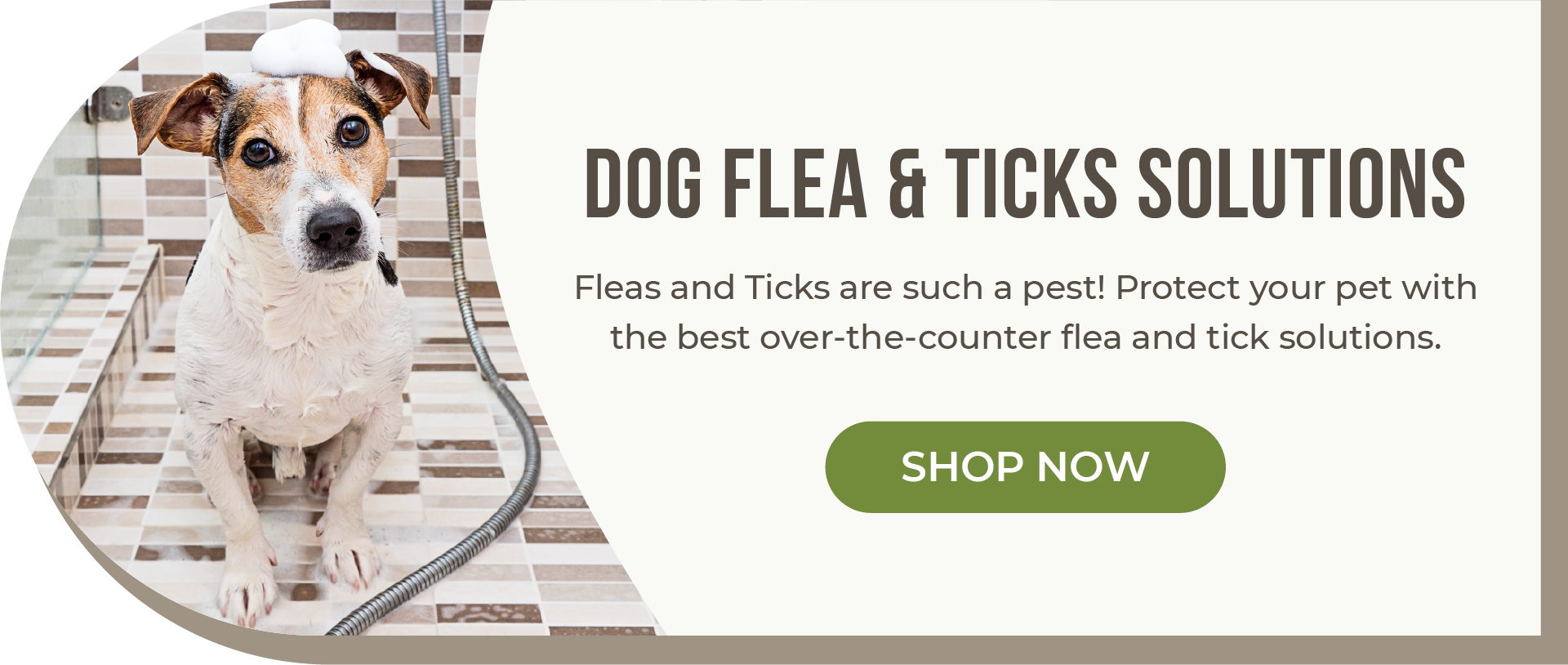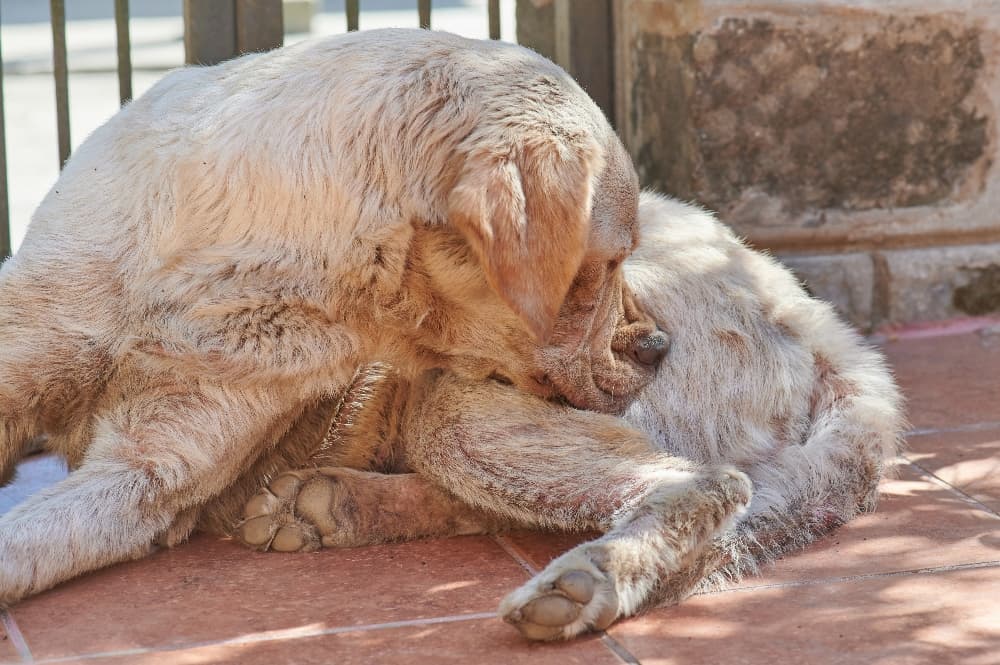
Bug bites can be a nuisance for your dog and can lead to serious health issues if not treated properly. Learn how to identify, treat, and prevent bug bites on dogs so that your dog can enjoy time outdoors pest-free.
When you're a pet owner, it's your responsibility to look after your furry friend's health. Recognizing, preventing, and treating different health ailments are part of being a good pet parent.
Even if you don't think that bug bites are a serious risk for you and your pet, you need to be prepared in case it becomes a reality.
Best-case scenario - the bite is only a mild annoyance; worst-case scenario, the insect bite transmits a life-threatening pathogen, or your dog experiences an extreme allergic reaction.
10 Most Common Dog Bug Bites on Dogs
Bugs are everywhere, and your dog is at a much higher risk of interacting with these pests. Whether your dog is trotting through tall grass, exploring bushes and shrubs, or actively chasing the squirming, buzzing, or scurrying insects, bug bites are a common issue for dogs.
Being lower to the ground and often a bit oblivious to insect activity, dogs come into contact with ants, flies, bees, mosquitoes, or spiders almost daily. Sometimes a bite or sting can go unnoticed, and other times it can cause discomfort, pain, infection, or worse.
Below, we'll go over common bug bites on dogs. This list is not comprehensive, but we tried to focus on the types of bugs that are most common in Canada and much of the United States.
1. Spider Bites
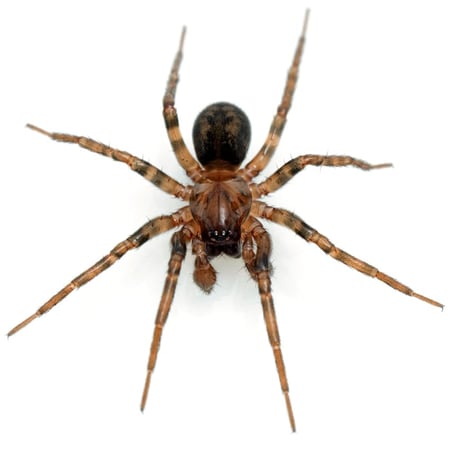
Spiders conjure up nightmarish horror scenes and strike panic into even the most fearless of us. But luckily, most spider bites in Canada and North America are harmless.
Most bug bites on dogs will cause nothing more than itchiness, minor pain, swelling, redness, and, of course, a serious case of the heebie-jeebies. Just me? OK, fine, but spiders do bite!
Dangerous Spider Bites
Most common spiders that find their way into your house are harmless. They are more likely to scurry away than try to take a bite of you or your dog. However, there are a few spider species that are dangerous enough to warrant learning how to recognize and avoid them.
Brown Recluse Spider Bites
The brown recluse's venom destroys red blood cells and causes local tissue damage around the bite site, making it the most dangerous spider found in Canada.
Brown recluse spiders are brown, often with a violin-shaped pattern on their back, and measure about 8-15 mm in body size with legs from 2-3 cm. You'll find them mostly in dark and uninhabited places where they are predominantly active at night.
The venom from a brown recluse spider bite on a dog kills the tissue around the site of the bite, creating a wound that is slow to heal, which can increase the risk of secondary infection. On occasion, the venom can enter the bloodstream, where it damages internal organs, which can lead to death.
Fortunately, they aren't native to Canada and generally don't tolerate our colder climate well. The spiders are usually accidentally transported into Canada from more tropical environments in products like fruit.
Black Widow Spiders
Another spider species that are not naturally native to Canada, the black widow, often makes its way here in fruit shipments, like grapes. Unfortunately, some species of black widows have established themselves in parts of BC and Southern Ontario, so they are more common than we'd like them to be.
Though black widows are thought to be deadly, they aren't quite as dangerous as most people think. A bite from a black widow is very unpleasant but rarely deadly.
Though we all have an image of a black widow spider in our heads - a sleek black body with bright red triangles on its underbelly - you may not know that this aesthetic is strictly for females. Males tend to be smaller and have more muted colours, like grey or brown and can feature white stripes instead of the signature red markings.
Wolf Spiders
This spider is the only native Canadian species of spider that is truly dangerous to dogs and humans. They are named for their hunting methods. Unlike most spiders that set up webs to trap their prey, wolf spiders hunt down their prey directly by charging them. Yikes!
While the wolf can be a more aggressive species, they typically leave larger mammals, like your dog, alone unless your curious pooch encroaches on their territory. The venom typically produces mild swelling, redness, and discomfort at the bite site.
What Do Spider Bites Look Like?
You may find a spider bite on a dog's face, foot, or tail. It all depends on how your dog approached the 8 legged pests. Investigate the swollen area thoroughly to find the bite wound and assess the damage.
So, what does a spider bite on a dog look like? The first thing you might notice is some swelling.
The wound may be small, depending on the size and type of spider that bit your dog, but it will often be red, swollen, and have a distinct puncture wound. The more dangerous the venom, the wider spread the reaction.
Common symptoms of necrotic venom from the brown recluse spider may cause a larger wound as the venom damages surrounding tissue.
After a bit of time, there might be a white lesion with a dark central scab that can develop into an ulcer that is slow to heal. Less common symptoms include anemia with bloody urine within the first 24 hours and fever with weakness within the first 2-3 days.
As with most health concerns, it's better to be safe than sorry. If your dog is showing signs of a more severe reaction to the bite, then contact your vet immediately.
2. Black Fly Bites/Gnat Bites
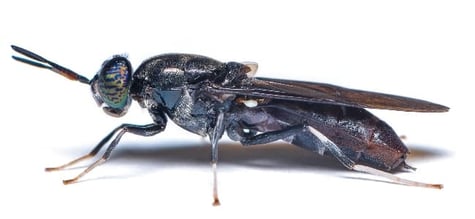
Black flies are sometimes also called gnats. (We call them annoying!) You'll catch black flies swarming around in large groups, and you can find them any time of year.
The flies like to live near streams, so be wary if you plan on exploring some waterways on your adventures.
What Do Black Fly Bites Look Like?
The painful bite looks like a flat, red splotch. Sometimes this splotch looks like a bullseye (about 1 cm wide) because of the outline, but this is not a reliable indicator. They'll go after exposed areas of your fur baby's body, so you might see black flea bites on the dog's belly or the groin.
When it comes to telling apart flies vs tick bites, sometimes people get confused because the dog shows the tell-tale bullseye wound caused by a Lyme disease rash from a tick.
However, this bullseye from ticks actually doesn't happen in dogs, so if you see your dog shows a bullseye, it is likely caused by a different insect (like black flies).
Other Fly Bites
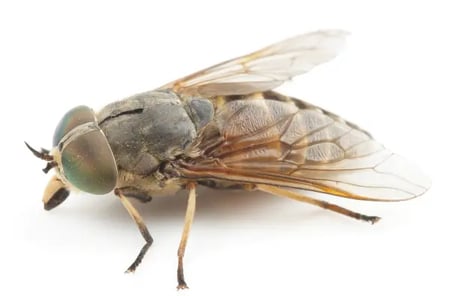
Though black flies are quite common in Canada, especially in more humid climates, they aren't the only type of fly that likes to bite dogs. Here are a few other types of flies in Canada that might nip your pooch:
- Horse Flies
- Deer Flies
- Sand Flies
- Stable Flies
Some of these larger fly species produce especially painful bites, which can cause an allergic reaction. Although not life-threatening, your dog can feel miserable and experience unpleasant side effects like facial swelling.
The real risk with fly bites in dogs is the risk of secondary infection from scratching or licking the itchy wound. The bigger the bite, or the more inflamed it is, the itchier and more uncomfortable it will be.
3. Ant Bites
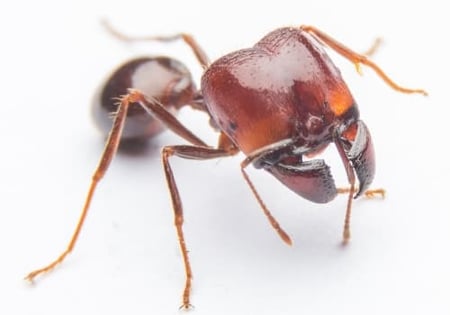
Ant bites are never fun and can range from mild to severe. Your fur baby's immune system reacts with its venom, which can cause swelling and pain in mild allergic reactions, and anaphylaxis on the severe end.
Since your pet is on its feet and leads with its nose, it's common to see ant bites on the dog's paws and mouth where they are likely to come in direct contact. Ant bites hurt, burn (especially fire ant bites), and itch on your dog's skin.
Common ant bite symptoms include difficulty walking due to bites on paws, hives, chewing or licking at the area, and swelling. Fire ants often swarm, causing hundreds of bites, which can impact your pet's health and even lead to difficulty breathing as they inject more venom. The bite of fire ants is extremely painful.
What Do Ant Bites on a Dog Look Like?
As one of the smaller pests on our list that bite dogs, the bites from ants are often small and can easily be missed if your dog isn't showing any signs of discomfort, but different species of ants can give varying degrees of painful bites. Luckily, allergic reactions are rare.
Here are some of the common types of ants in Canada and the types of bites you can expect from them:
4. Bed Bugs on Dogs
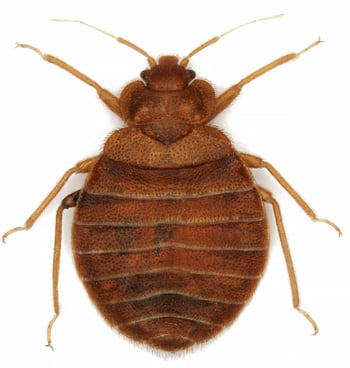
Bed bugs will bite onto your dog, feed, and then release themselves, so it's not too likely you'll actually see any bed bugs on dogs.
However, if you are worried about your dog carrying bed bugs and spreading them to you and your house, you should be. One female bed bug can hitchhike on your pooch's fur, or you can bring one home on your pant cuff - an infestation is born.
What do Bed Bug Bites Look Like on a Pet?
Excessive itching will likely be the first indicator that something's up. Bed bugs often bite in a line or cluster, and because of their teeny size, produce small reddened dots in a group.
You might also see some suspicious translucent shed exoskeletons lying around, along with black spots that smear when you try to clean them (bed bug droppings) or bloodstains on bedding.
5. Mites on Dogs
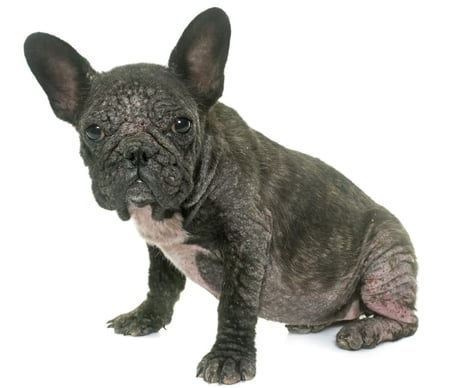
What are mites on dogs? Mites refer to a number of different microscopic parasitic organisms. You might hear of grass mites on dogs, harvest mites on dogs, and oak mite bites. They're usually less than 1 mm in length, meaning they can be easy to miss.
They can't fly but don't celebrate just yet. They make great hitchhikers and can reproduce very quickly. They spend their entire 17-21 day lives on the host, so that's a lot of time to reproduce and spread.
If the mite infestation lasts long enough without treatment, it can cause mange.
What is Mange?
Mange is a disease caused by unchecked mite infestations. When the mites are able to populate quickly, they spread across your dog's body and start feasting.
Female mites burrow into your dog's skin and lay eggs. A full-blown infestation leads to extreme and often full-body skin damage as the little pests eat away at the top layers of skin.
Sarcoptic Mange
You might hear mange referred to as canine scabies. This is referring to sarcoptic mange. It is highly contagious to other dogs and even to humans, so it's always best to treat mites quickly before sarcoptic mange develops and spreads.
Demodectic Mange
This type of mange is also caused by an infestation of mites, but a different kind of mite. These mites are always present on your dog's skin and are a natural part of the ecosystem that is their body.
Mange is diagnosed through a skin scraping test performed by your veterinarian. Treatment usually involves a combination of topical medications, oral medications, and/or medicated baths. In severe cases, your dog may need to be hospitalized for treatment.
What are Ear Mites?
Ear mites are a common problem for dogs and can cause discomfort and irritation in their ears. These tiny parasites can be identified by the dark, coffee-ground-like debris they leave behind in the ear canal.
Home remedies or a vet visit can clear up the biting insects and reduce swelling in the ear canal.
6. Fleas on Dogs
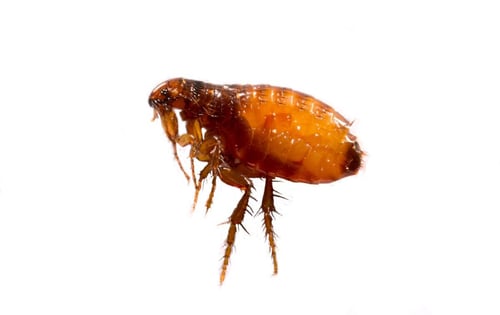
Fleas send shivers down any pet lover's spine. Fleas feed on your pooch's blood and leave tiny raised nodules behind that itch and stay inflamed for weeks. Some poor dogs are more sensitive than others to flea dirt and can be sent into itchy misery after just one flea bite.
It doesn't take much for an infestation to take hold in your home. All it takes is one flea to hop onto your furry friend, and you're in for the long haul.
If you notice your pet scratching or licking themselves more than usual, it might be time to check them for fleas.
Fleas like dark, humid areas, like the neck, ears, lower abdomen, and tail base. Because of their small size and dark colour, they can be hard to spot, so the fleas themselves likely won't be the first sign.
What Do Flea Bites Look Like?
Look for clusters of bite marks, as well as “flea dirt” that turns from brown to red once it is wet by a paper towel. Scabs might pop up from repeated scratching and biting, and if your pet keeps reopening them, it could lead to secondary infections and complications. They might also start losing hair in those areas.
Pets that have flea allergy are particularly sensitive and can develop flea allergy dermatitis. If they end up swallowing a flea infected by a tapeworm, they can also develop tapeworms. Luckily, tapeworms usually don't cause immediate harm and can be treated with medication by your vet.
Tapeworms in Dogs
Though not as dangerous as heartworms spread by mosquito bites, tapeworms are transmitted through flea bites. Tapeworms live in the digestive tract for a long time if not caught.
A dog owner should have their dog checked for tapeworms if they have been exposed to multiple flea bites or flea saliva.
7. Tick Bites on Dog
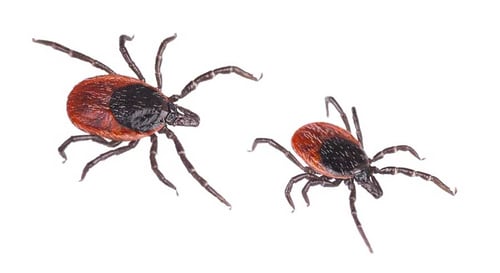
Ticks occur in warmer months and like to feed on the blood of their host, which can include you and your pup.
Tick bites will usually cling close to the head, neck, feet, and ears. You'll be able to spot them if you look. Their bites aren't usually painful, but they can carry diseases such as Lyme disease and parasites.
What Do Tick Bites Look Like on Dogs?
Tick bites are usually unique from other pest bites for two reasons. This is because ticks burrow into the skin to feed, so the bite wound usually still has a tick in it.
You may be able to see the tick's body sticking out, or the tick bite can fully burrow into the skin, leaving a hard, raised bump.
Learn more about how to spot, treat, and prevent tick bites in Ticks on Dogs.
8. Lice Bites on Dogs
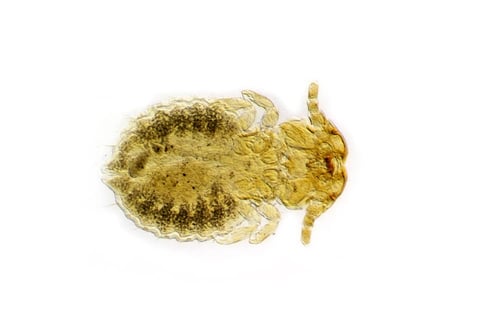
Lice are small, flightless bugs that can live in your pet's hair (and yours, for that matter). The pests feed on skin debris, secretions, and blood. (Nice.) Some dogs have an allergic reaction.
The eggs of lice are called nits, and they're glued to the hairs near the skin of their hosts. Unfortunately, you can't dispose of them with just a simple bath.
What do Lice Bites on Dogs Look Like?
As with most bites, oftentimes, the first sign of a problem is scratching and biting. There might be small wounds from the bites that can become infected. You can diagnose lice by seeing the lice themselves or seeing their eggs in your pet's fur.
Fortunately, lice can be treated with most flea and tick treatments.
9. Mosquito Bites on Dogs
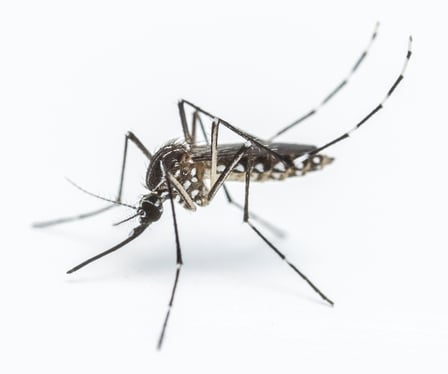
Mosquitoes suck... literally.
Mosquitoes are more than just annoying pests – they can also transmit diseases such as heartworm to your beloved pet.
These flying pests are a fact of summer, and if you spend time outdoors with your dog, then you will have to deal with mosquitoes. They thrive in humid climates and are more active in the evening when the sun is less hot.
What Does the Mosquito Insect Bite Look Like?
You are probably already familiar with a mosquito bite or two, or twenty... thousand, and the results are quite similar in dogs. Round, raised, and irritated bumps form at the bite site, leading to an insatiable itch.
The more your dog licks and scratches to try to soothe the itch, the bigger and more irritated the bites can get. They can get infected if not treated properly, leading to even further irritation and skin damage.
Along with the bites, mosquitoes also carry a risk of parasites, bacteria, and viruses.
Learn more about these pests and how to protect your pet in Treating Mosquito Bites on Dogs.
10. Bee Stings on Dogs
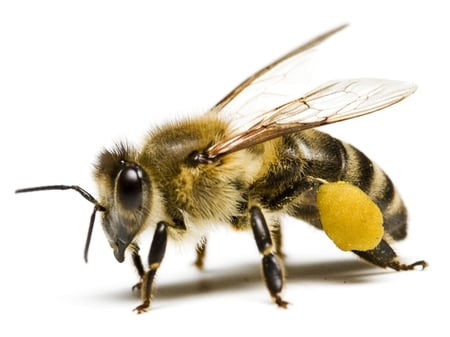
Even though we are talking about insect bites on dogs, some pests don't bite, they sting. The results can be just as unpleasant and painful, though. Fortunately, stings from insects can be prevented and treated very similarly to common bites.
Every once in a while, a curious pup sticks its face in a pretty flower, only to be met by a bee. The classic image is a dog with a puffy face, but they're also prone to bee stings on their paws (or anywhere they come into contact with those buzzing jerks).
What Do Bee Stings on Dogs Look Like?
The effects of a bee sting on a dog's body can range from mild to severe and can lead to difficulty breathing or worse.
If a severe allergic reaction occurs, take the dog to the vet immediately, as the situation can become life-threatening. Anaphylactic reactions can include severe symptoms like swelling of the insect sting location, trouble breathing, facial swelling, intense pain and cardiac problems.
If you suspect your dog is experiencing anaphylactic shock from the bee sting, seek immediate veterinary help for the serious allergic reaction.
Learn more in Bee Stings on Dogs.
Home Treatments for Bites On Dog
Lots of common bites and stings can be easily treated at home if they are not causing difficulty breathing or a life-threatening reaction.
Once you've identified the type of pest that has infiltrated your dog's body and caused the allergic reaction, you can choose treatments such as pet-safe soap to clean, soothe, and evict the pests.
Best Pest Control Treatments for Dogs
While many of the topical treatments above can help deal with the bite, they won't dispose of the pests that are driving your pet crazy.
Bayer K9 Advantix
Monthly treatments, like Elanco K9 Advantix II Topical Flea & Tick Protection, are designed to prevent fleas, ticks, and other pests from latching onto your pooch, but can also help control pests that have already set up shop.
Capstar Flea
This fast-acting treatment kills adult fleas quickly and safely. Capstar Flea Treatment will kill 98% of fleas in just six hours and 100% within 24 hours, providing your pet with fast-acting relief from pests.
Best Dog Bug Bite Treatments
The first step to treating bites is a disinfectant treatment to remove bacteria and other debris from the bite site. Try one of these products:
Thrive Silver Shield
Silver is one of nature's most effective antiseptics. It is thought to have natural anti-bacterial, anti-viral, and anti-fungal properties that can be used to disinfect any small wounds without stinging or drying out the skin.
Treat bug bites with Thrive Silver Shield is an easy spray-on silver mixture that is safe for use on dogs and even lick-safe.
True Leaf Natural Response Topical Gel
Another natural wound and infection topical treatment, True Leaf Natural Response Gel uses pet-safe ingredients like olive oil and honey to protect against harmful bacteria and help kickstart the healing process of the bite.
Best Dog Anti-Itch Treatments
Most insect bites itch! You want to relieve the dog's symptoms, whether from a flea bite, fire ants or other pests.
By combining an anti-itch treatment with the wound care treatment, you can prevent the bites from driving your dog nuts and keep them from worsening. Here are a few options to reduce your dog's itch and kickstart the healing process:.
Skout's Honor Probiotic Itch Relief
Not all bacteria are bad. In fact, healthy bacteria are an excellent way to keep itch-causing bacteria naturally at bay. Skout's Honor Probiotic Itch Relief will not only reduce insect bites itchiness but can help to fight off bacteria that can slow the healing process.
Tropiclean OxyMed Anti-Itch Medicated Spray
For itchiness, consider products like Tropiclean OxyMed Anti-Itch Medicated Spray to help soothe skin quickly. The soothing nature of oatmeal helps ditch the itch, while vitamin E helps to heal damaged skin faster.
Acorn Pet Calm Paws Calming E-Collar
Sometimes the itch is just too great, so the best way to prevent your dog from fussing over a bite from a bug is to keep them from being able to reach it. The Acorn Pet Calm Paws E-Collar is a safe and effective way to help small wounds heal.
Dog Pest Control Treatments
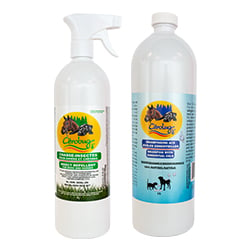
Some bugs need an extra deterrent to stay away from your pet. Bug sprays for people often contain toxic ingredients that aren't even good for us, let alone our pets, so a pet-safe protectant from pests is a great idea if your dog is an outdoor adventurer.
Here are a few of the best ways to tell bugs to buzz off:
Citrobug
Products like Citrobug Insect Hunt made from essential oils, can help keep flies, mosquitoes, and other flying pests away. Simply spray it on like bug spray each time to venture into the wild.
Blends for Life Diatomaceous Earth
Blends for Life Diatomaceous Earth may help protect against mites and fleas at home by destroying their exoskeletons, leading to total body dehydration. The finely ground powder can be sprinkled onto your pet's coat to make your dog an inhospitable environment for any pests that get curious.
Frequently Asked Questions
What are the common signs of bug bites on dogs?
Itching, redness, swelling, and bumps are common signs of bug bites on dogs.
Can bites on dogs be dangerous?
Yes, some bug bites can lead to allergic reactions, infections, or even diseases.
What insects can cause bites on dogs?
Mosquitoes, fleas, ticks, mites, and flies are common insects that bite dogs and can cause bug bites on dogs.
How can I prevent insect bites on my dog?
You can use insect repellents, keep your dog indoors during peak bug activity, and use flea and tick prevention products.
What should I do if my dog has a bite?
Treat bug bites with a cold compress (ice pack) to reduce swelling so that you can assess the bite. Minor bites can be healed quickly with a topical treatment, while more severe reactions may warrant a quick call to your vet for the most appropriate next steps.
Can I use human bug bite remedies on my dog?
No, you should always consult with your vet before using any human remedies on your dog, as some can be harmful or ineffective for dogs.
.png?width=200&height=66&name=logo%20(1).png)

